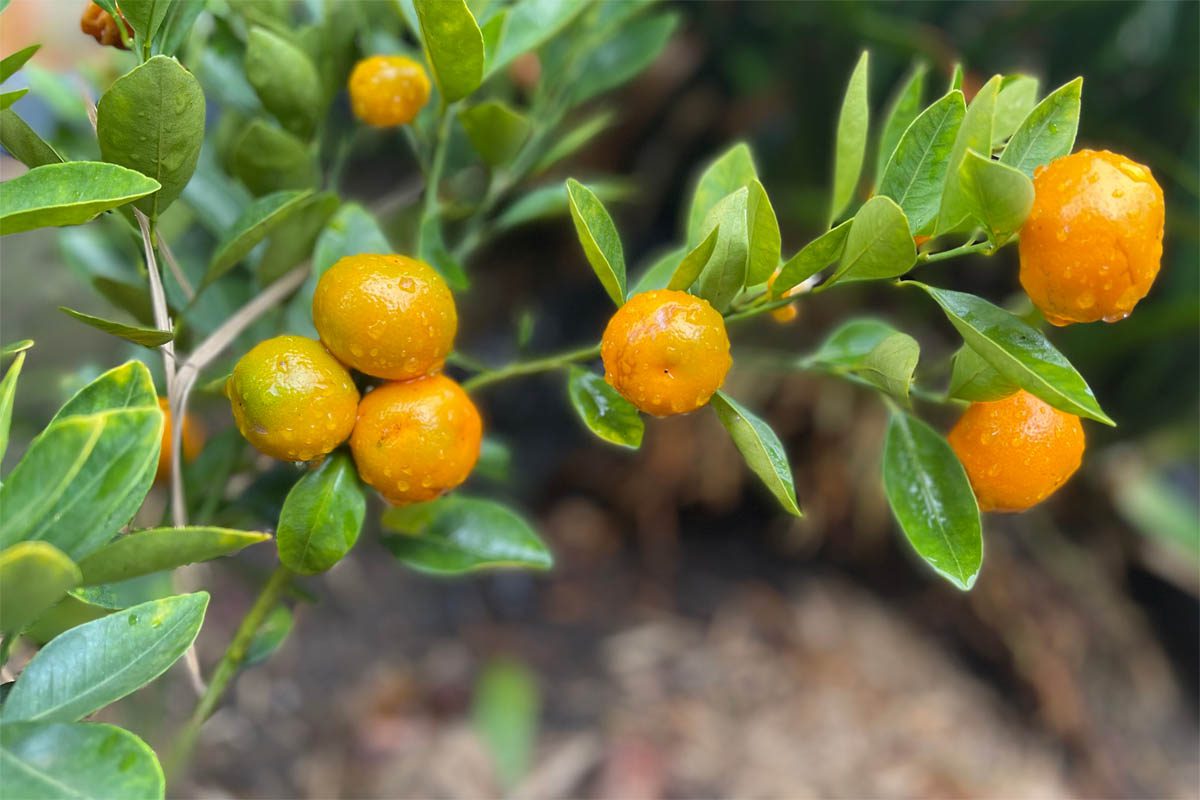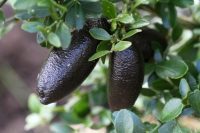What is calamondin? Ι Appearance Ι What does calamondin taste like? Ι Nutritional information Ι Uses Ι How to harvest and store calamondin Ι How to grow calamondin Ι Where to buy calamondin Ι What’s the difference between calamondin and kumquat? Ι Recipes
What is calamondin?
Calamondin (Citrus × microcarpa), also commonly known as calamansi, Phillipine lime, China orange and calamandarin is a type of acid citrus, from the family Rutacea. The precise origins of calamondin are somewhat uncertain due to its long history of cultivation, but it is believed to have originated in China as a hybrid between a kumquat and a wild species of mandarin. The calamondin was likely carried by traders and travellers along maritime trade routes to other parts of Asia, including the Philippines where it remains hugely popular.
Calamondin is commonly grown throughout the Philippines, both agriculturally and in home gardens. It’s used extensively in local Filipino cuisine, both as fresh fruit and in processed forms like juices, jellies, and sauces. Calamondin is also a key ingredient in many traditional Filipino health remedies.
Synonyms
- Kalamansi
- Philippine lime
- Calamandarin
- Golden lime
- Panama orange
- Philippine lemon
- Chi chieh
- China orange
- Lemonsito
Calamondin names around the world
- Kalamandinë (Albania)
- Calamondini (Italy)
- Limau kasturi, Limau chuit (Malaysia)
- Ma-nao-wan (Thailand)
- Shikikitsu, Tôkinkan (Japan)
- Szu kai kat (China)
- Kalamunding, Kalamansi or calamansi (Philippines)
- Djerook kastoori(Java)
- Calamondina (Madagascar)
Despite its popularity in Southeast Asia, the calamondin is one of the lesser-known citrus varieties in many parts of the world. In recent years, its popularity has grown due to its year-round fruiting and ornamental appearance, and it is now widely available in garden centres.
Calamondin was introduced to the United States as an ‘acid orange‘ in the early 20th century. This was part of a broader pattern of plant and crop exchange between the United States and its territories, including the Philippines, which came under American control following the Spanish-American War in 1898. During this period, there was significant interest in introducing new and exotic fruits to the United States. Agricultural explorers brought back a variety of plant species, including many types of citrus.
Appearance
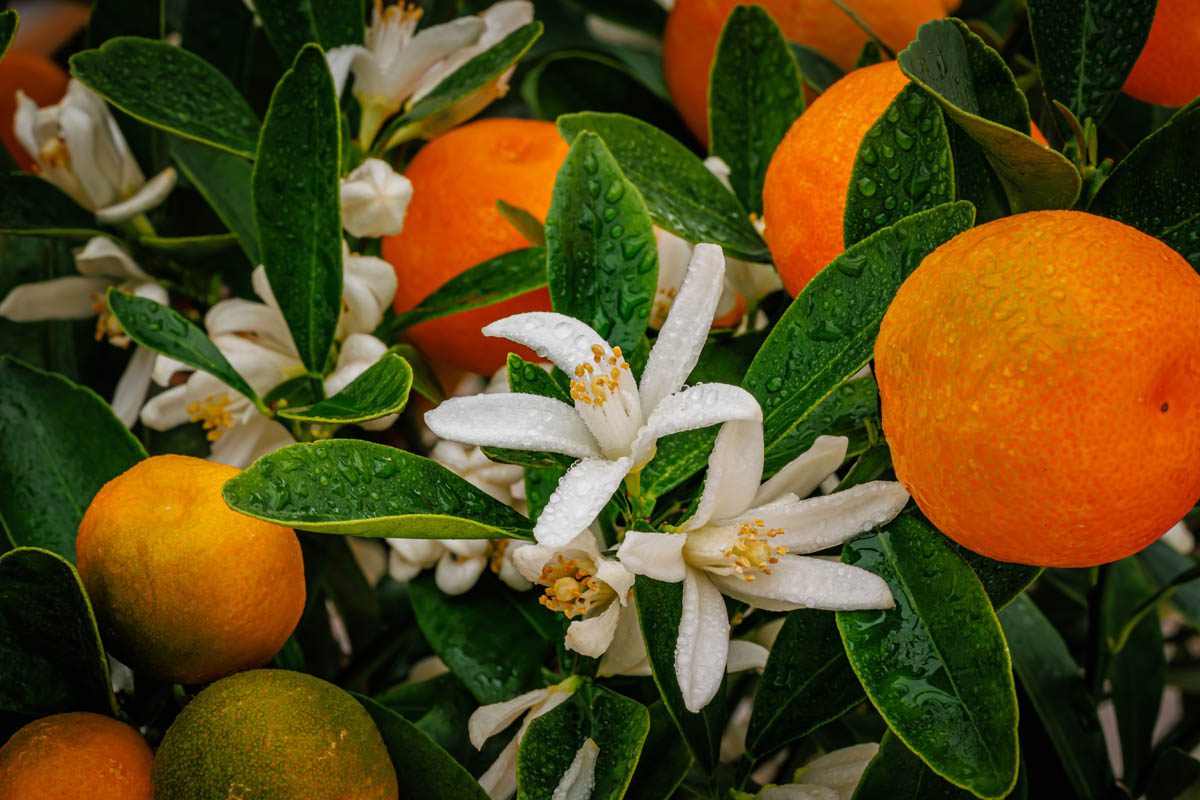
- Tree: The calamondin tree typically grows in a rounded or umbrella shape with a dense canopy, referred to as a globular or spherical form. Calamondins are considered small trees or large shrubs, usually growing 3-6 metres tall. The calamondin has an evergreen habit, retaining its leaves throughout the year. Overall, the calamondin tree is quite compact and well-suited to container growing, which makes it a popular choice for indoor or patio gardening, especially in regions where outdoor conditions are not ideal for citrus cultivation.
- Leaves: Calamondin leaves are classified as ‘simple leaves‘, which means each leaf consists of a single leaf blade, with a bud at the base. The leaf shape is ‘elliptical‘ (oval), which is typical of the citrus family. These leaves are glossy, dark green on the top and lighter green underneath. Leaf length is 3-7 cm, the leaf margin (edge) is smooth and they are arranged on the stem in alternate formation, ie; not directly across from each other on the stem. The leaf apex (tip) is acute, to slightly acuminate (tapering to a pointed end), and the base is cuneate (wedge-shaped).
- Fruit: The bright orange fruit is around 5 cm in diameter and has a similar oblate shape to that of a small tangerine (spherical, flattened at the poles). The rind is very thin, loose, smooth and firm and is dotted with oil glands. Inside, the fruit is divided into 8 to 12 segments, with juicy pulp and small seeds. Calamondin fruit is classified as ‘hesperidium’, which is a specific type of berry with a leathery rind found in the citrus family. Inside, the fruit is divided into 8 to 12 segments, each enveloping a juicy pulp. These segments are surrounded by a somewhat spongy pith. The fruit contains several seeds that are small, pointed, and ovoid or oblong in shape.
- Flowers: Calamondins produce what is known as ‘perfect flowers‘, which means each flower has male and female structures. The sweetly fragrant flowers are small, white and typically 1 cm long. They are arranged singly, or in small clusters in the leaf axils. Each flower is made up of five petals, and numerous stamens. The shape of the flower is ‘actinomorphic‘, which refers to its radially symmetrical shape. Peak blooming time is spring, but calamondins in temperate zones produce flowers and fruit year-round.
What does calamondin taste like?

Calamondins have a unique taste that combines the elements of different citrus varieties. The skin is sweet, while the juicy flesh is tart and tangy, similar to a kumquat.
When the calamondin fruit is eaten whole, the sweet skin balances out the tart flesh. This unique taste profile of sweet and tart makes the calamondin a versatile ingredient in a wide range of dishes and can enhance both sweet and savoury recipes.
The Brix level (denoted by °Bx), is the sugar content of an aqueous solution. One degree Brix corresponds to 1 gram of sucrose in 100 grams of solution, thus representing the strength of the solution as a percentage by mass. The Brix scale is used in the food and beverage industry to measure the approximate amount of sugars in fruits, vegetables, juices, wine, and more.
As you can see from the chart below, the calamondin has a Brix level similar to that of limes.
| Fruit | Brix Level (approximate) |
|---|---|
| Bergamot orange | 8 – 10 |
| Buddha’s hand | 6 – 8 |
| Calamondin | 6 – 7 |
| Clementines | 12 – 13 |
| Dekopon | 13 – 14 |
| Etrog | 8 – 10 |
| Finger lime | 8 – 10 |
| Grapefruit | 9 – 12 |
| Key lime | 6 – 8 |
| Khasi papeda | 8 – 10 |
| Kumquat | 8 – 9 |
| Lemon | 8 – 9 |
| Lime | 6 – 8 |
| Makrut lime | 6 – 8 |
| Mandarins | 10 – 13 |
| Micrantha | 8 – 10 |
| Orange | 12 – 14 |
| Pomelo | 10 – 12 |
| Satsuma | 12 – 13 |
| Tangerine | 12 – 14 |
| Sudachi | 6 – 8 |
| Yuzu | 9 – 11 |
Nutritional information
The average weight of a calamondin is 30 grams, for reference, a medium lemon weighs approximately 200 grams.
According to the University of Texas, one calamondin is 12 calories and contains 1.2 grams of fibre, 37 mg potassium, 7.3 mg vitamin C, 57.4 mg IU vitamin A, 8.4 mg calcium, 15.5 g water and 3.1 g carbohydrates.
Uses
Food and drink: In Filipino cuisine, the calamondin used when it is still green and unripe. The tart, acidic taste is valued in many Filipino dishes. It is often used as a souring agent in dipping sauces, soups and marinades.
Uses in Filipino cuisine
- Kinilaw: a traditional Filipino dish similar to ceviche, where raw fish, is ‘cooked’ in an acidic marinade of vinegar and calamondin juice, and mixed with onions, ginger, chilli, and other seasonings for a refreshing and tangy appetiser.
- Toyomansi: A popular Filipino condiment consisting of soy sauce (toyo) and calamondin (mansi), often used as a savoury dipping sauce or marinade to enhance the flavours of grilled meats, fish, and other dishes.
- Sisig: A traditional Filipino dish made from parts of a pig’s head (snouts, jowls and ears) and liver, often seasoned with calamondin and chilli, and served sizzling on a hot plate.
- Pancit: A noodle dish, seasoned with calamondin for a tangy flavour, and typically includes meat, vegetables, and sometimes seafood
- Arroz caldo: A comforting Filipino rice porridge dish, similar to congee, traditionally made with chicken, rice, and flavoured with ginger, garlic, onions, and garnished with scallions, crispy fried garlic, boiled eggs, and calamondin or lemon juice for a touch of acidity.
- Siomai: A traditional Filipino dumpling filled with pork mince, beef, prawns or vegetables, and often served with a calamondin-soy sauce dip for a tangy kick.
- Aligue fried rice: A rich Filipino dish made with crab fat, garlic, rice, and seasonings, typically brightened with a squeeze of calamondin for a touch of acidity.
Beyond its use in food, calamondin also finds its way into drinks and cocktails, adding a unique flavour profile and is an essential ingredient in desserts, sweet pickles, and marmalades, showcasing its versatility in both savoury and sweet preparations.
Food: In Western cuisine, calamondin can be used when ripe in a similar way to kumquat, lemon or lime and can be used in cakes, marmalades, marinades and drinks. See the end of the article for calamondin recipes.
Personal care: Calamondin is used in personal care products in the Philippines. Rich in vitamin C, potassium and antioxidants, calamondin is used as an antiperspirant as well as in skin care to brighten the skin, reduce the appearance of age spots and combat damage from free radicals.
Household uses: Calamondin can be used as a natural cleaner due to its high citric acid content. The juice can remove stains, clean surfaces, remove ink stains from clothes and even act as a natural insect repellent.
Ornamental plant: Due to its attractive appearance, year-round flowering, fruit set, and compact nature, calamondin is often grown as an indoor or outdoor ornamental plant in Florida and California. If it is grown inside, but you would still like to enjoy its unique fruit, hand-pollination will be necessary.
How to harvest and store calamondin
Harvest when the fruit is a vibrant orange. Take care when picking calamondin as the thin skin can easily tear when the fruit is picked (see image below), use a sharp pair of scissors to snip the fruit from its stalk.
Calamondin can be stored for up to a week at room temperature or two weeks in a refrigerator. The juice can be squeezed into ice cube trays and frozen.
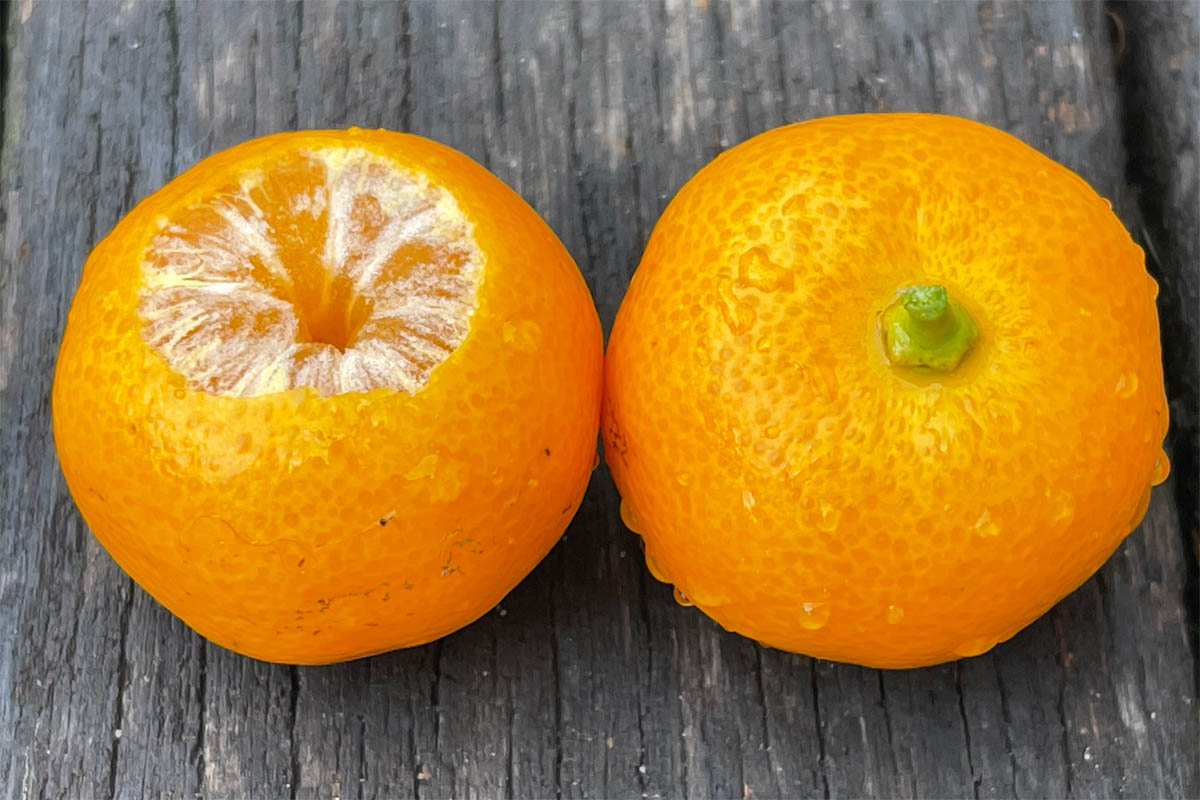
How to grow calamondin
The calamondin is a sun-loving plant with similar care requirements to other citrus varieties and can be grown in a pot or in the ground. Potted calamondins make a spectacular outdoor feature on a deck or patio, and unlike other citrus varieties, they are frost-hardy down to -6°. Bear in mind that a potted calamondin will not produce as much fruit as one in the ground, however, my three potted calamondins still produce between 20-40 fruits each. I don’t have a mature calamondin, but for comparison, in its peak, my kumquat in the ground produced hundreds of fruit.
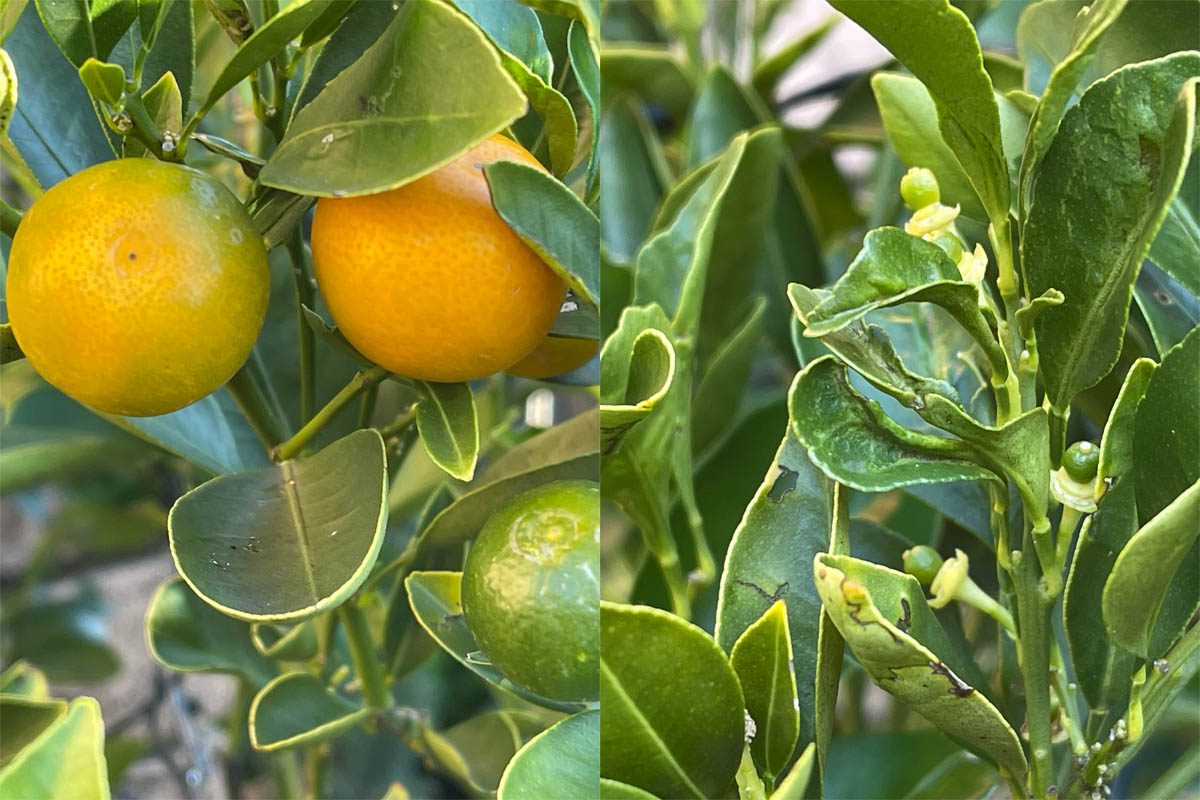
Planting
- The best time of year to plant your citrus tree is in spring when the soil temperature is warming up. Never plant young trees into cold soil.
- Put the tree in its container into a bucket and fill it with water. Allow it to soak for 10 minutes. Remove the pot from the container taking care not to damage the roots. Leave the tree in the water until it is ready to plant.
- If planting in the ground, mix in plenty of organic fertiliser, dig a hole twice the width of the tree, and add 1 kg of superphosphate and 0.5 kg of organic fertiliser. Work thoroughly into the soil.
- Place the tree in the centre of the hole and carefully spread out the roots out and down. Backfill the hole with soil. Do not plant your citrus too deep as they are surface feeders. Add a 5-10 cm layer of mulch, to conserve moisture, moderate soil surface temperature and deter weeds. Leave a ring around the trunk of the tree mulch free to prevent collar rot.
- Citrus roots are concentrated in the top 30-50 cm of soil and do not like plants around the base of the tree. Weed regularly and resist the temptation to plant companion plants around the base.
| Light | At least six hours of full sunlight a day |
| Water | Give a deep water at least once a week, or more often in hot weather and less in winter. Citrus prefer a uniform level of moisture around the root zone. It is important to ensure the tree has constant moist soil (but not saturated) during flower bud formation through to the final fruit set to ensure a good crop. Feel the leaves on hot days, if they feel cool, the tree has enough water, if they feel dry or leathery, they need more water. |
| Soil | Use well-draining, organically rich soil. Soil pH should be between 6.0 and 7.0. Look for a citrus-specific potting mix or a premium potting mix if growing in pots. |
| Temperature | Calamondin prefers temperatures between 15°C (60°F) and 29°C (85°). |
| Fertiliser | Feed with a slow-release fertiliser in spring, as well as a water-soluble citrus fertiliser every month during the growing season (spring to early autumn). Do not fertilise in autumn or winter. |
| Humidity | Moderate, between 40-50%. |
| Pruning | Prune to maintain shape and size after the fruiting season. Remove dead or diseased branches as needed. |
| Repotting | Repot every 2-3 years or when the tree becomes root bound. Spring is the best time for repotting. |
| Pest control | Watch for common pests like aphids, scale, and spider mites. Use a horticultural oil or soap to control these pests. |
| Pollination | Self-pollinating and does not need another citrus tree for self-pollination. |
| Harvest | Harvest in mid to late winter when the fruit is bright orange. |
Where to buy calamondin
Outside of Asia, calamondin fruit is not typically available in fruit shops or supermarkets. However, most garden centres or online nurseries sell grafted calamondin trees for the home grower. I’ve noticed the availability of calamondin trees increasing in garden centres over the past two years.
It will take up to ten years for your calamondin tree to reach its full size, but smaller trees do produce fruit. It is generally recommended you remove fruit from immature trees so they can put their energy into growth and not fruit production.
What’s the difference between calamondin and kumquat?
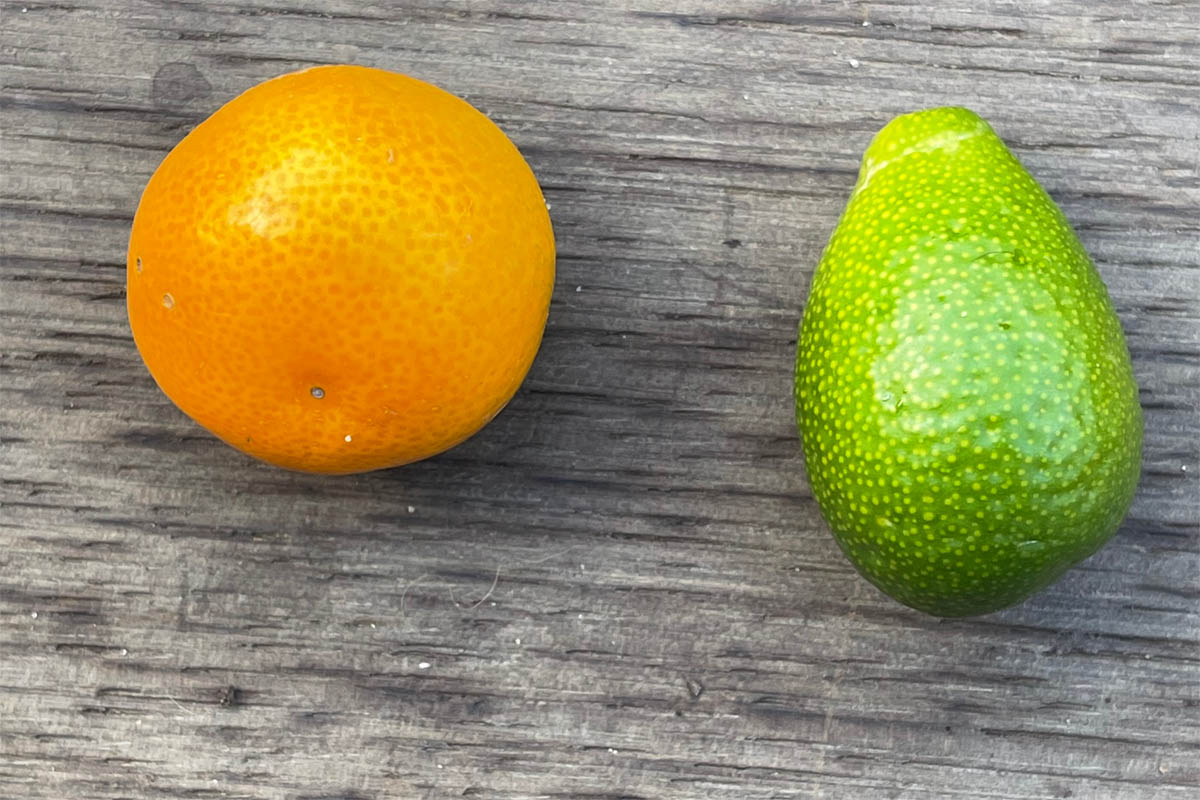
| Calamondin | Kumquat | |
| Origin and distribution | China but now widely cultivated in Southeast Asia, especially the Philippines |
South Asia and the Asia-Pacific region |
| Fruit appearance | Small, round and orange, approximately 2.5-5 cm in circumference | Small, oval approximately 2-4 cm in circumference |
| Tree height | Mature height of 3 metres | Mature height of 4.5 metres |
| Plant characteristics | Small, shrub-like and can be kept indoors as an ornamental plant | Larger, and while they can also be kept as ornamental plants, they are often grown outdoors. |
| Usage | Beverages, desserts, marinades, condiments | Eaten whole, preserves, flavouring in baked goods and drinks |
| Seed count | Up to 12 per fruit | 2-5 per fruit |
| Leaves | Small and oval, glossy green | Larger, darker and more elongated |
| Growth rate | Faster | Slower |
| Fruiting season | Year-round | Early spring |
| Hybrid status | Believed to be a cross between a kumquat and a mandarin or tangerine | Own genus (Fortunella) within the citrus family |
You may notice that online plant retailers often refer to calamondin as ‘kumquat calamondin‘, there is no such thing. While the calamondin is a hybrid of kumquat and a wild mandarin, it is a variety within its right now. This creates confusion for buyers, the tree is either a kumquat or a calamondin.
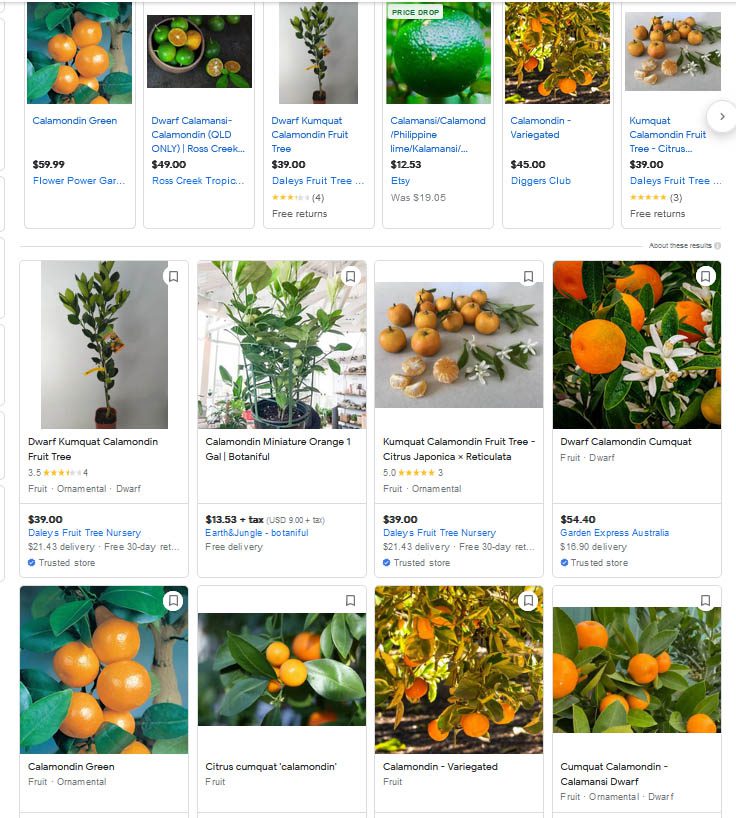
Recipes
I find hand-squeezing calamondin is the easiest way to juice them as they are too small for traditional citrus juicers. You will end up with a little pulp in the juice, but this can be sieved out. Each calamondin will produce approximately 5 ml of juice. So a recipe calling for 250 ml of calamondin juice will require 50 calamondins.

1 cup = 250 ml
| Calamondin marmalade | Ingredients:
Instructions:
|
| Calamondin cooler | Ingredients:
Instructions:
|
| Calamondin chicken | Ingredients:
Instructions:
|
| Calamondin vinaigrette | Ingredients:
Instructions:
|
| Candied calamondins | Ingredients:
Instructions:
|
| Calamondin sorbet | Ingredients:
Instructions:
|
| Calamondin simple syrup | Ingredients:
Instructions:
|
| Calamondincello | A twist on the traditional limoncello which is an Italian liqueurIngredients:
Instructions:
|
Julia is a writer and landscape consultant from Wollongong with a love of horticulture. She had been an avid gardener for over 30 years, collects rare variegated plants and is a home orchardist. Julia is passionate about learning and sharing her knowledge of plant propagation and plant toxicology. Whether it’s giving advice on landscape projects or sharing tips on growing, Julia enjoys helping people make their gardens flourish.
